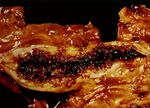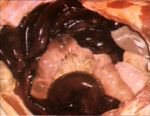Difference between revisions of "Category:Intestine - Vascular Disturbances"
Jump to navigation
Jump to search
(Created page with ' * Vascular disturbances cause obstruction of efferent veins, blockage of afferent arteries or reduced blood flow through unobstructed circulation. ** All have similar effects on…') |
|||
| Line 1: | Line 1: | ||
| − | |||
* Vascular disturbances cause obstruction of efferent veins, blockage of afferent arteries or reduced blood flow through unobstructed circulation. | * Vascular disturbances cause obstruction of efferent veins, blockage of afferent arteries or reduced blood flow through unobstructed circulation. | ||
** All have similar effects on the intestine | ** All have similar effects on the intestine | ||
| Line 12: | Line 11: | ||
** 4 - 5 hours - all mucosa necrotic, sloughed. | ** 4 - 5 hours - all mucosa necrotic, sloughed. | ||
| − | == Venous Congestion == | + | ==[[Intestinal Venous Congestion]] == |
| − | |||
| − | |||
| − | |||
| − | |||
| − | |||
| − | |||
| − | |||
| − | |||
| − | |||
| − | |||
| − | |||
| − | |||
| − | |||
| − | |||
| − | == Arterial | + | ==[[Intestinal Arterial Thromboembolism]] == |
* Non-strangulation infarction. | * Non-strangulation infarction. | ||
Revision as of 13:06, 1 June 2010
- Vascular disturbances cause obstruction of efferent veins, blockage of afferent arteries or reduced blood flow through unobstructed circulation.
- All have similar effects on the intestine
Effects of Intestinal Hypoxia
- Intestinal hypoxia is induced by vasular distrubances (above).
- Timescale:
- 10 – 30 minutes - separation of epithelium from basement membrane.
- 1 - 2 hours - villus destruction.
- 2 hours - necrosis of crypt cells.
- 4 - 5 hours - all mucosa necrotic, sloughed.
Intestinal Venous Congestion
Intestinal Arterial Thromboembolism
- Non-strangulation infarction.
- There is often a functional obstruction at point of infarction.
- Relatively rare as the bowel has a good anastomosing blood supply.
Horses
- E.g. Strongylus vulgaris larvae migrating in cranial mesenteric artery in horse
- Cause arteritis with thickening of wall
- Due to fibrin and debris deposition and hypersensitivity reaction
- Leads to vasoconstriction
- May occlude lumen and encourage thromboemboli.
- Can cause ischaemic necrosis of a segment of small intestine
- Is less common now that Strongylus vulgaris infections are declining.
- Cause arteritis with thickening of wall
- E.g. equine salmonellosis.
Small Animals
- Especially dogs
- Road traffic accidents produce and infact in the gut.
- Renal disease also causes infarction.
- Particularly nephrotic syndrome.
- Anticoagulant proteins are lost in the urine, leading to a prothrombic state in the ciruclation.
Pathology
- Similar to that caused by venous congestion.
- See sharply delineated dark areas in bowel that are flaccid with loss of tone.
- These become necrotic followed later by peritonitis.
Pages in category "Intestine - Vascular Disturbances"
The following 2 pages are in this category, out of 2 total.

